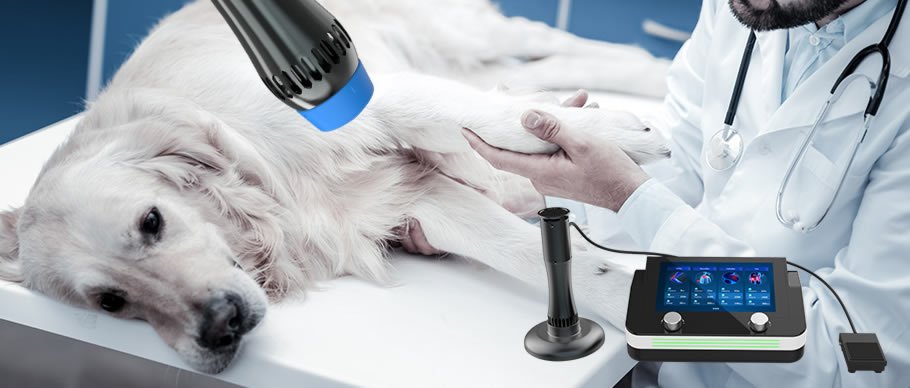
Shockwave therapy for dogs
Is your furry friend struggling with mobility issues or suffering from chronic pain? Say goodbye to discomfort and embrace the revolutionary healing power of shockwave therapy for dogs! This cutting-edge treatment uses gentle acoustic waves to target and accelerate the healing process of musculoskeletal conditions.
Watch your pup regain vitality as shockwave therapy works wonders on tendon and ligament injuries, bone fractures, and joint inflammation. Promoting increased blood flow and cellular repair, it’s the non-invasive solution your canine companion needs.
Give your dog the gift of a pain-free, active life. Experience the transformative benefits of shockwave therapy for dogs today!
Extracorporeal Shock Wave Therapy (ESWT) has demonstrated its effectiveness in treating a range of conditions for dogs, including:
- Tendon and ligament injuries (such as shoulders, Achilles, and partial CCL tears)
- Bone fractures (both delayed or non-unions and post-TPLO procedures)
- Osteoarthritis (OA) and joint inflammation
- Cauda equina syndrome (LS Disease)
- Wounds and lick granulomas
Shockwave therapy procedure in dogs
The Shockwave Therapy procedure for dogs follows a careful step-by-step process to ensure optimal results:
Comprehensive Diagnostic Examination:
The veterinarian will conduct a thorough diagnostic examination, including a physical check-up, blood work, urinalysis, and possibly a fecal examination. Radiographs or an ultrasound of the injured area may also be taken to assess the condition.
Gentle Sedation:
To keep the canine calm and ensure precise application, the dog will receive light sedation before the treatment.
Preparing the Treatment Area:
The area of the dog’s body that requires treatment will be shaved to provide a clear and optimal field of contact.
Applying Contact Gel:
A contact gel will be applied to the dog’s freshly shaved skin to enhance the effectiveness of the procedure.
Initiating Shockwave Therapy:
The handpiece, which is connected to the energy source, will be carefully applied to the dog’s affected area to deliver the therapeutic shockwaves.
Clinical outcomes of ESWT for dogs
Based on Clinician’s Brief:
Non-Healing Fractures:
Among 4 treated dogs, 3 exhibited significant improvement in bone healing after ESWT treatment.
Distal Radial Fracture Non-Unions:
Dogs receiving ESWT achieved complete bone healing after 12 weeks, while the control group had no complete bony union.
Soft Tissue Shoulder Conditions:
ESWT led to improvement in 88% of dogs, without the need for surgical intervention.
Knee Joints Inflammation:
ESWT significantly reduced distal ligament thickening in dogs after CCL rupture surgery.
Achilles Tendon Health:
ESWT promoted the development of new blood vessels at the bone-tendon interface in dogs.
Modulating Osteoarthritis:
ESWT decreased nitric oxide production in joints and inhibited cell death in healthy cartilage, aiding in osteoarthritis management.
Alleviating Arthritis Pain:
ESWT demonstrated benefits in managing arthritis pain.
Enhanced Joint Function:
Studies showcased positive outcomes in joint range of motion and peak vertical force for dogs with knee, hip, and elbow arthritis.
Shockwave therapy prevention in dogs
In many cases, the requirement for shockwave therapy in dogs can be avoided, particularly when it comes to injuries. Simple yet effective dog safety measures at home, such as keeping your dog indoors, in a fenced yard, or on a leash during outdoor activities, significantly reduce the risk of injuries. While degenerative conditions and diseases may be unavoidable, maintaining your dog at a healthy body weight can play a crucial role in preventing the need for this therapy. Obesity places excessive strain on the joints and exacerbates degenerative joint conditions, adding to the stress on affected areas. By proactively ensuring a safe and healthy environment for your beloved canine companion, you can greatly minimize the likelihood of requiring shockwave therapy.

[1] Mueller, M., Bockstahler, B., Skalicky, M., Mlacnik, E., & Lorinson, D. (2007). Effects of radial shockwave therapy on the limb function of dogs with hip osteoarthritis. Veterinary Record, 160(22), 762-765.
[2] Becker, W., Kowaleski, M. P., McCarthy, R. J., & Blake, C. A. (2015). Extracorporeal shockwave therapy for shoulder lameness in dogs. Journal of the American Animal Hospital Association, 51(1), 15-19.